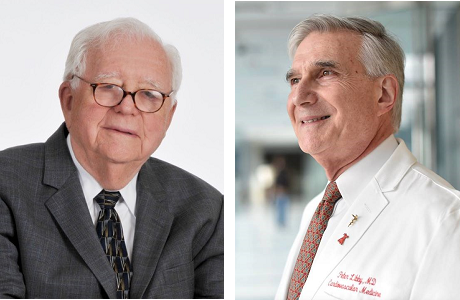When “Braunwald’s Heart Disease” debuted in 1980, Peter Libby, MD, had just finished his training at the old Peter Bent Brigham Hospital. His chief, Eugene Braunwald, MD, the founding editor of what would become the leading textbook of cardiovascular medicine, gave Dr. Libby a copy at the author’s price with one provision: He had to review and provide notes on the pacemakers chapter.

Dr. Libby, who is now a cardiovascular specialist in the Division of Cardiovascular Medicine at Brigham and Women’s Hospital and Mallinckrodt Professor of Medicine at Harvard Medical School, went on to become an editor of the sixth edition and has held an editorial role ever since. He served as editor-in-chief of the eighth edition and then of the 12th edition, which was released late last year.

This edition of “Braunwald’s” offers the usual in-depth coverage of the latest developments in clinical science, clinical and translational research, and evidence-based medicine. The book features more than 1,900 pages, 76 new contributing authors, 14 new chapters and two new editors: Deepak L. Bhatt, MD, MPH, executive director of the Brigham’s Interventional Cardiovascular Programs, and Scott D. Solomon, MD, director of the Brigham’s Clinical Trials Outcomes Center.
“The reason we end up with this preponderance of editors and authors from the Brigham is simple: Our criterion is excellence,” Dr. Libby says. “Who can do the best job? Who has the greatest expertise? And I think we made a convincing case to the publisher that having three editors from the Brigham was the best thing for the book.”
Ready for the Challenge From Day One
Dr. Braunwald edited the first five editions of his tome by himself. When it came time for the sixth, he decided to get some assistance.
“He sat me down and told me he was thinking about the future of the book,” Dr. Libby recalls. “He wanted to enlist Dr. Douglas Zipes [of the Indiana University School of Medicine] and me as co-editors with him, and I said, ‘My entire life has been preparation for this moment.'”
Dr. Libby is now well-acquainted with the meticulous process of assembling each edition. The cycle begins with a retreat where the editors discuss prospective chapters. They have at their fingertips data gleaned from the online version of the book, which reveals which topics are generating the most interest among readers. In preparing the 12th edition, the editors also had their fellows provide input on many of the chapters.
“We don’t just go by our hunches. We have both quantitative data and feedback from our trainees to determine how we can best meet the readers’ needs,” he says.
A hallmark of “Braunwald’s” is the profile of the authors. “One of the things we are very careful about—and it’s a point of difference for us—is that our authors are usually household names in cardiology,” Dr. Libby says. “We are very mindful of their level of expertise; all of our authors have actually contributed to the field with their own original research.”
Textbook’s Founder Maintains an Active Role
Still very active, Dr. Braunwald was heavily involved in the development of the 12th edition. Besides regularly discussing content with the editors, he wrote the first chapter (“Cardiovascular Disease: Past, Present, and Future”) and co-authored a second chapter.
Dr. Braunwald also takes the lead in updating the electronic version of the book twice monthly. “He reviews five major cardiology journals, winnows out what is the most important information and then posts the updates himself,” Dr. Libby says.
A guiding principle for the editors is resisting what Dr. Braunwald calls “obesity” in the book. Although it may be nearly 2,000 pages, the editors make it a point to include only the latest, most relevant information.
“The criteria for whether something gets into the book are, is this something that is reliable? Is it reflecting the state of the art? Will it be useful to both the practitioner and to the trainee who’s studying for their qualifying exams? It’s a heavily curated book, and that’s probably one of the key reasons for its success,” Dr. Libby concludes.
